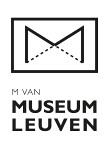From A to K
April 29–September 18, 2016
L. Vanderkelenstraat 28
B–3000 Leuven
Belgium
Hours: Thursday 11am–10pm,
Friday–Tuesday 11am–6pm
T +32 16 27 29 29
info@mleuven.be
M - Museum Leuven presents Brussels-based Austrian artist Aglaia Konrad in a first major solo exhibition in Belgium. Konrad has developed a distinct manner of photography that documents the rapidly advancing process of global urbanization. Her archive, which encompasses several thousand images of urban infrastructures and housing architectures, offers an unlimited repository that sheds a unique light on the relationship between society and space. The artist rearranges her works for each new exhibition and installation.
Her photographs, films and installations zoom in on exceptional buildings, investigate the transformation of cities and examine the overlapping between sculpture, architecture and film. Although Aglaia Konrad pursues a documentary approach, her work is not architectural photography in the usual sense. Her extensive studies of urban structures are based upon an understanding of space that may be taken as a complex system of signs and codes, actions, representations, allocations of meaning and resulting power relations.
From A to K brings a selective overview of Konrad’s oeuvre from the late 1990s until today, and highlights its diversity. Konrad presents amongst others the new photo series “Shaping Stones,” “Zweimal Belichtet” and “Avebury Full Circle,” together with the new film La Scala about a villa on Lake Garda. She also produces a work for the museum facade.
In the last room, Suchan Kinoshita presents the exhibition experiment TOKONOMA, together with Aglaia Konrad, Olivier Foulon, Jörg Franzbecker, Kris Kimpe, Willem Oorebeek, Eran Schaerf and Walter Swennen.
Curator: Eva Wittocx
New publication
The new monograph From A to K is structured and typeset like an encyclopedia, offering a generous selection of unpublished images, both in color and in black-and-white, which are accompanied by an alphabetical list of headwords whose insistent presence multiplies the book’s organizing structure. This list reflects the artist’s longstanding engagement with the shifting dimensions of public and private environments as they materialize in architecture, urbanism, and the city.
With texts by Friedrich Achleitner, Hildegund Amanshauser, Elke Couchez, Penelope Curtis, Michiel Dehaene, Steven Humblet, Moritz Küng, Spyros Papapetros, Angelika Stepken, Edit Tóth, and the editors, and interventions by the artists Koenraad Dedobbeleer and Willem Oorebeek.
Published by Koenig Books, Cologne
Biography
Aglaia Konrad (1960, Salzburg) became well-known through documenta X and Manifesta 9. Next to solo exhibitions in the Museum of Contemporary Art, Siegen, Germany; DeSingel, Antwerp; and Camera Austria, Graz, Austria, she participated in an array of meaningful exhibitions dealing with the city as a theme: Cities on the Move, 1998 and 1999 in Bordeaux, New York, London, Helsinki, and Vienna; Metro>Polis, Brussels, 2000; Shanghai Biennale, 2000; Future Cities in Canada, 2004; KOPIE CITY in the Kunsthaus Graz, Austria, 2004; Spectacular City. Photographing the Future in NAI - Nederlands Architectuur Instituut Rotterdam/Artforum North Rhein-Westphalia, Düsseldorf, 2006/2007. In 1997 the artist was awarded the Otto Mauer Prize of Vienna, in 2003 the Camera Austria Prize of Graz, and in 2007 the Albert-Renger-Patzsch-Prize of the Dietrich Oppenberg Foundation and Photography Collection. Many of her publications have been awarded with prizes.
Aglaia Konrad is represented by Galerie Nadja Vilenne, Liège and Galerie Raum mit Licht, Vienna.
Also in M
Oriol Vilanova (1980, Spain) has taken M’s art collection as the starting point for his first solo museum exhibition At first sight. How do museums present artworks in an exhibition or on a postcard? Does the object get a chance to tell its own story? The artist explores these questions in three new installations. He collected 35 display cases from a variety of Belgian museums and similar institutions and shows them for what they are by leaving them empty. In this way, Vilanova emphasizes the furniture itself and questions its neutrality. The 2,800 postcards on the walls of one of the rooms, each showing an object against a monochrome background, raise questions about the pseudo-neutrality of the postcards.
March 18–June 5, 2016
Press: for more information, please contact Veerle Ausloos: veerle.ausloos [at] leuven.be.

